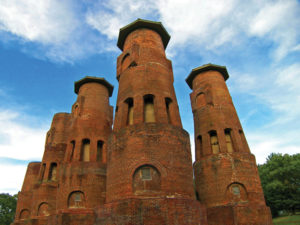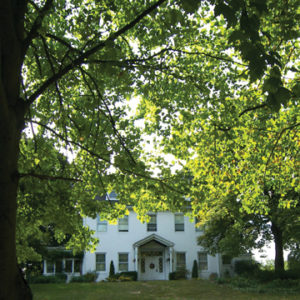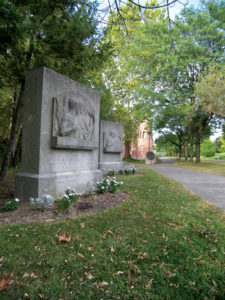Coplay, Hokendauqua, & Fullerton
By Kathryn Finegan Clark
 Coplay, Hokendauqua and Fullerton: these three little Lehigh County communities hug the western bank of the Lehigh River as it flows toward Easton where it empties into the Delaware River.
Coplay, Hokendauqua and Fullerton: these three little Lehigh County communities hug the western bank of the Lehigh River as it flows toward Easton where it empties into the Delaware River.
They are, for the most part, pleasant little residential areas dotted with shady trees, wide porches on row homes, green lawns and flowers. Now, in the 21st century, their prominent place in the growth of industry and business in the Lehigh Valley and in the nation is as surprising as it is assured.
The communities are remnants of three giant industries that fueled the Lehigh Valley’s growth for entire generations and put money in the pockets of wealthy entrepreneurs as well as poor immigrants brought from Europe to build new lives in an exciting although frightening new land.
Coplay will forever be associated with cement, Hokendauqua with iron and Fullerton with the railroad industry.
The northernmost town, Coplay Borough, was carved from Whitehall Township in 1869. Hokendauqua and Fullerton are actually neighborhoods in the township. All were company towns, typical of the kind of communities corporations built to house and control their labor forces.
Coplay, the oldest of the three communities, is part of 400 acres bought by John Jacob Schreiber from the sons of William Penn in 1740. It later took its name from Kolapechka, son of Indian Chief Paxinosa.
The sleepy village actually sprang into life after David O. Saylor purchased land and established the Coplay Cement Co. in 1866. The little town had been transitioning from an agricultural to an industrial base even before that with the coming of the Lehigh Valley Iron Co. in 1853. Later called Coplay Iron Co., it drew Irish immigrants as workers.
The cement mill, a silk mill, a cigar factory and a knitting mill all hired labor from both the borough and neighboring Hokendauqua. As business expanded, both towns became melting pots of Germans, Irish, Austrians, Hungarians, Czechoslovakians, Polish and Ukranians. Now the residents work all over the Lehigh Valley and beyond, but even though their work has taken them away they still love the little town that has, as one resident put it, “lots of churches and lots of bars.”
By 1900, the area around Coplay provided the nation with 75 percent of its cement, and by the 1920s, America was the world’s leading producer of cement, largely due to the Lehigh Valley enterprises.
leading producer of cement, largely due to the Lehigh Valley enterprises.
Standing as a silent memorial to the industry are the oldest cement kilns in the United States. Constructed with locally made red brick in 1866, the kilns now overlook the town’s swimming pool on Second Street and are listed on the National Register of Historic Places.
The 90-foot tall kilns were constructed for the production of Portland cement. They were considered an improvement in kiln technology over what was called a bottle or dome kiln commonly used at that time. The tall kilns had offered the advantage of producing a higher quality product and also produced cement on a continuous basis, but soon they, too, became obsolete with the onset of a rotary kiln technology which required very little labor to operate.
Hokendauqua, which measures roughly one square mile, takes its name from the Delaware Indian language and means “landing.” It was built by the Thomas Iron Co. for its workers and laid out by the company on November 9, 1854. The company also named the streets and built homes in 1868 for the iron work’s general superintendent and other executives; then it built rows of brick houses for all its employees.
The company was founded by David Thomas, a Welsh ironmaster who had come to America in 1839 to work for the Lehigh Crane Iron Company. One of his sons, Samuel Thomas, organized the new company and under his direction it built two furnaces on a farm owned by a family named Butz along the Lehigh River.
That marked the beginning of the community that was to become Hokendauqua. Two furnaces were “put in blast” in 1855. The Thomas family was considered exemplars of the iron industry and continued to build furnaces in the community, one in 1862 and another in 1863.
The company had its own plant railroad that included about a mile-and-a-half of tracks to connect with the Ironton Railroad at West Coplay. The family also had plants in nearby communities and in New Jersey and produced record quantities of iron.
Their prominent place in the growth of industry and business in the Lehigh Valley and in the nation is as surprising as it is assured
The production of local iron declined and the Hokendauqua plant was abandoned in 1927. It was later sold to Bethlehem Steel which scrapped it in 1936.
The third community, once called Ferndale but now named Fullerton, is built on three separate tracts of land, one settled by Giles Windsor in 1767, another by Stephen Snyder in 1786 and a third by Jacob Yundt in 1826. But the landowners lay forgotten by 1895, when the town fathers opted for a name change to Fullerton, to honor James W. Fuller Jr., a local entrepreneur.
Fuller purchased a company that manufactured wheels used for railroad cars from Frederick and Co. and renamed it McKee, Fuller & Co. in 1865, later changing it to the Lehigh Car, Wheel & Axle Works.
Fuller laid out the town in 1870 and 13 years later it had become a thriving company town that was home to more than 1,500 workers and their families. It continued to prosper when Fuller’s company began to produce machinery for the mills and quarries in the vicinity of the three towns.
Fullerton property that once was farmland and later home to a baseball field is now the site of the sprawling Lehigh Valley Mall, the first enclosed super regional shopping center in the Lehigh Valley. The land was bought in 1958 by Max Hess Jr. of Hess’s department store chain and sold several times before its official opening in 1976.
 The mall was renovated 20 years later and just three years ago went through another renovation and major expansion. The 88-acre mall now includes 20 outdoor shops and restaurants. The mall is managed by Kravco Simon Company and its three anchor stores are J.C. Penney, Macy’s and Boscov’s.
The mall was renovated 20 years later and just three years ago went through another renovation and major expansion. The 88-acre mall now includes 20 outdoor shops and restaurants. The mall is managed by Kravco Simon Company and its three anchor stores are J.C. Penney, Macy’s and Boscov’s.
Retail business now reigns where industry once ground its wheels and the mall remains a powerful magnet for Lehigh Valley shoppers.
Kathryn Finegan Clark is a National Press Club Award winner who has been writing “Because You Live Here” and other departments for Lehigh Valley Marketplace for several years.




